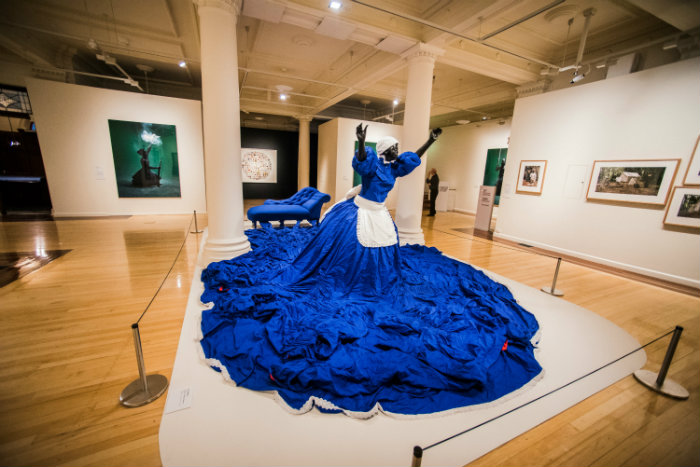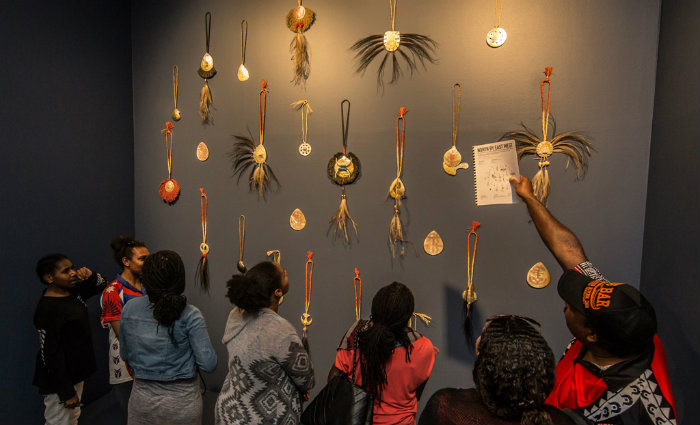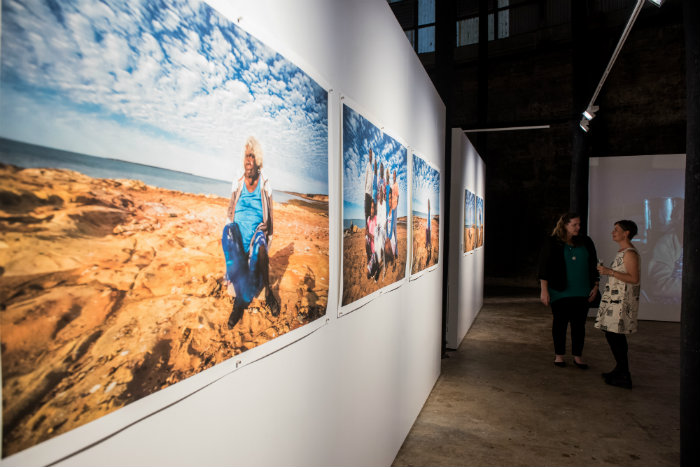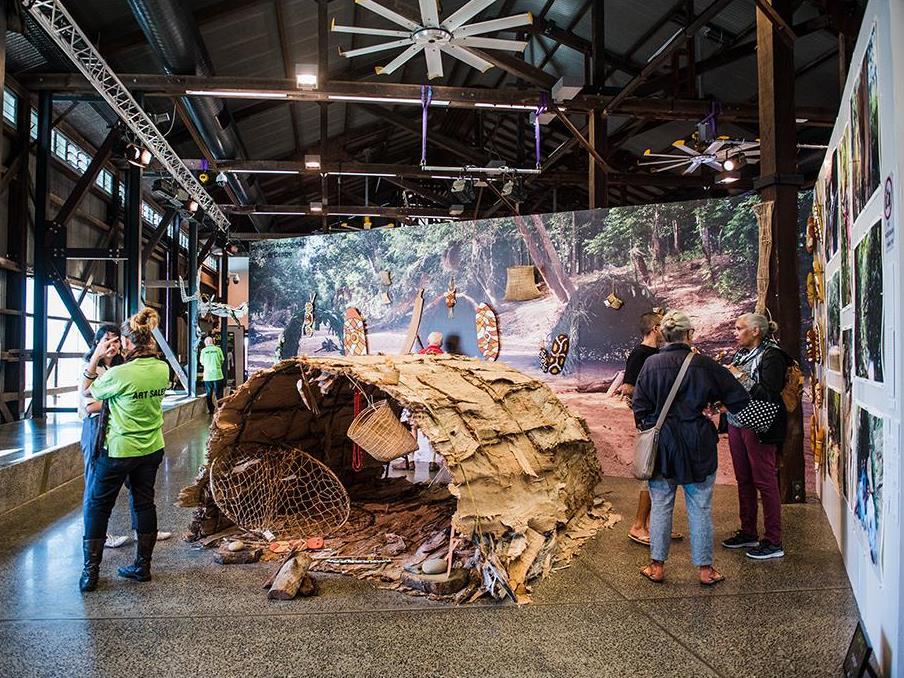Girringun Arts at Cairns Indigenous Art Fair, image supplied.
The Cairns Indigenous Art Fair (CIAF) this year celebrated its ninth year and has grown from its original sophisticated art fair at The Tanks Art Centre and other local art spaces to encompass a wide-ranging arts event across Cairns. It now includes an art fair and art market; exhibitions curated by its Artistic Director Janina Harding working with other galleries; awards; a fashion parade; films and theatre, as well as the Indigenous dance and music performances that have enriched the event since its beginnings.
This year CIAF opened with a bang (not just the fireworks, a quirk of the opening night which I’m not convinced is a necessary inclusion) on the Wednesday before the weekend’s fair, with a co-curated series of exceptional exhibitions at Cairns Art Gallery.
Continental Drift Black/Blak Art from South Africa and North Australia is the first exhibition of contemporary South African and Aboriginal Australian art. Featuring such major contemporary Australian artists as Fiona Foley, Tony Albert, Michael Cook and Archie Moore, the exhibition also includes powerful art by South African artists including Mary Sibande, Mohau Modisakeng and Kudzanai Chiurai. Continental Drift is an investigation of colonisation and its enduring impacts, which has been a theme of much contemporary art significantly since the 1980s, but these artists have explored the theme in ways which feel very current and fresh. Surprisingly, this is the first time an Australian gallery has curated an exhibition of South African and Aboriginal Australian artists, and the exhibition concept is one that works. The senior curator, Julietta Park, has done an exceptional job with the execution of the exhibition.
At its centrepiece is a large sculptural work by Mary Sibande, using her motif of ‘Sophie’, a motif the artist describes as a ‘genomic avatar’ or performative alter ego, made to the artist’s own proportions. Sophie symbolises the history of black women’s servitude in South Africa. This arresting central work, I Decline, I refuse to Recline, consists of a sculpture of Sophie in her voluminous blue Victorian dress, with white apron and hat, arms uplifted, with an enormous extended skirt and a chaise longue in the same blue. The figure looks as though she is running away from or to something, liberated through her mind.

Mary Sibande, I Decline, I Refuse to Recline, 2010, mixed media. Image supplied.
The South African works give resonance and a further sense of legitimacy to the Australian works, such as Foley’s arresting Horror has a face series, which explores the chilling history of the artist’s country and its Southern Protector of Aborigines from the late 1800s. This exhibition illustrates that colonial violence and oppression is not a uniquely Australian experience. Australia was but one part of the extensive impact of the British Empire’s expansion, an expansion that impacted throughout many parts of the world. Continental Drift strengthens the efforts of Indigenous Australian artists to draw attention to the enduring impact and brutality of this British colonisation.
The curatorial innovativeness in these series of CIAF exhibitions includes Continental Drift artist Dale Harding’s invitation to Cairns Art Gallery assistant curator, local Aboriginal and Torres Strait Islander artist Teho Ropeyarn, to engage with his work Black days in the Dawson River Country – Remembrance Gowns, by performing a ‘tally/composition of stencils in red ochre in remembrance of the Aboriginal victims of those violators (Fraser and company).’
Two more CIAF exhibitions at Cairns Art Gallery were also innovative, but for a different reason: they focused on traditional Aboriginal & Torres Strait Islander jewellery, craft and design in a contemporary way. Mara: Indigenous Design, Politics and Food Culture, co-curated by local artist Bernard Lee Singleton and Teho Ropeyarn, beautifully showcased an impressive collection of art and objects from Far North Queensland, including many from the Kowanyama Culture and Research Centre. This exhibition effectively captured the impressive traditional design concepts of Indigenous people from this region and conveyed the continued use of these tools.
North by East West: re-igniting a cultural connection through pearl shell, co-curated by Janina Harding and Teho Ropeyarn, created impact with its striking wall installation of Cairns based, Saibai Islander Joel Sam’s dibi dibi: pearl shell and fibre neckpieces that were traditionally worn for ceremony and protection in battle. The creation of prints by the Bard brothers Darrell and Garry Sibosado from Lombadina, Western Australia, of traditional pearl shell designs were sophisticated geometric artworks that conveyed the beauty and symbology of their people’s tradition in a new and engaging way. This bringing together of cultures from opposite sides of Australia to explore connections made through art was exciting, and the accompanying film which featured the visit the brothers from the Kimberley made to the Torres Strait showed the ways art can connect across borders and vast distance, as well as the historical connections Indigenous Australians share through culture.

Installation view, North by East West at Cairns Gallery. Image supplied.
The CIAF Art Fair proper, now housed in the Cairns Cruise Liner Terminal (a spacious converted wharf with a stunning backdrop of blue sea and green mountains) was also mostly very impressive. Queensland had a wave of high-level sophisticated art movements when CIAF was first created, born from a blend of remote art centres such as Mornington Island and Lockhart River which became major movements in Australian painting; Aurukun who did similarly in sculpture; the now famous Torres Strait Islander printmakers; and the political intellect and contemporary movement of artists based in Brisbane. For a while that peak slumped, but now it feels as though CIAF is riding and helping to propel the crest of its second wave.
From an experiential view, what also stands out to the visitor is the sense of agency in the execution of the fair, and its great sense of celebration. At the entrance visitors are greeted by friendly staff, many of whom are Aboriginal and Torres Strait Islander: one has the feeling this is a largely Indigenous organised and run event. Within the brutal politically charged history of Queensland, this is refreshing and enlightening. The rich program of cultural dance, music, fashion and activities adds to this sense of agency and celebratory feel.
The fair is separated into both an art fair and an art market, which provides a range of art for all levels of viewers and collectors. In the fair, notable stands included Nganthanun Bamawi Bayan – Hope Vale Arts & Cultural Centre, located on the Eastern Cape York coast. They exhibited a joyous series of paintings by Grace Rosendale of her sacred sand dunes of the Binthi warra clan, in a lovely pastel colour palette, and Daisy Hamlot’s whimsical naïve minimalist paintings with animal figures. Pormpuraaw Arts & Cultural Centre featured impressive large-scale sculptural work created from ghostnets, one of which, an awe-inspiring crocodile by Kim Norman, was quickly acquired for $17,600. Newcomers Bana Yirriji Art Centre displayed fresh new paintings by Lila Creek, Anne Nunn and Dianne Winkle, who has mastered the challenging technique of pastel and ochre on paper.
Wik and Kugu Art Centre, of Aurukun, were again a hit with their Ku’: camp dog sculptures by Gary Namponan and others, and a delightful Vernon Marbendinar sculpture of rainbow birds and parrots in a tree. The Ku’ dogs seem slightly less whimsical and stiffer than their previous renditions, but collectors did not seem to mind.
Girringun, the art centre in Cardwell known for its ceramic Bagu sculptures, created an imaginative large-scale installation of a Midja dwelling, executed largely by artist Abe Muriata, who is significant in helping bring back the fine bi-cornial basket weaving tradition.
The fair also showcased some exciting contemporary art from commercial galleries, including a large-scale painting by Mavis Ngallametta at Martin Browne Contemporary and a noteworthy mixed-media exhibition by Elisa Jane Carmichael at Onespace Gallery. Carmichael’s contemporary jewellery and weaving work were particular standouts.
An interesting new movement CIAF showcased is Indigenous-owned ARIs (Artist-Run Initiatives). Not exactly an art centre, which is community owned, individual artist Naomi Hobson has created a space, born out of a disused squat, in her community of Coen for ceramicists and painters to work in a professional studio. This entrepreneurial artist is backing the project with her own funds and judging by the ceramic work exhibited under the name of the Kalan Clay House, and Hobson’s own highly contemporary looking photographic works being acquired by major public galleries from the stand, her gamble is well worth it.
Far North Queensland was a major force in printmaking, but it seems to have become less fine lately, with artists choosing to work in the more accessible, less challenging medium of lino printing, rather than the fine etching days of CIAF’s early glory years. Badu Art Centre displayed some culturally significant prints of traditional neckpieces. But the printmaking displays at KickArts Contemporary Arts at the Centre for Contemporary Arts did not engage me, considering when one remembers the first works made by the very young artists from Lockhart River. These and the Moa Arts prints, Malu Mabaigal – Seafaring People, were not as finely detailed or executed as we have come to expect from artists from this region.

Photographs from Mornington Island, Pride in Authority, The Tanks Art Centre. Image supplied.
Across town at The Tanks, CIAF had co-curated another project-based exhibition series, Pride in Authority. This three-part exhibition involved the curators actively engaging with artists on country in Cape York: Bentinck and Mornington Islands, Pormpuraaw and Aurukun, where they ran workshops in photography and worked towards this major exhibition. Striking woven sculptures from Pormpuraaw in recycled materials, photographic and moving images, and beautiful colourful paintings on paper by Netta Loogatha of Mornington Island combined to create an evocative and diverse display. The opening remarks by senior artist Syd Bruce Shortjoe, who speaks nine Indigenous languages, were – amongst all the dynamic dance, music and the fashion parade at CIAF – the most impactful.
That there can still be many more mythologies, philosophies and knowledge living on in the lush tropical forests and coastline of this region became apparent to me. Queensland isn’t over yet, it seems, it still is evolving and creating new art for us all.
Cairns Art Gallery:
Continental Drift Black/Blak Art from South Africa and North Australia
Until 23 September ’18
Mara: Indigenous Design, Politics and Food Culture
Until 9 September ’18
North By East West: re-igniting a cultural connection through pearl shell
Until 19 August ’18
Cairns Indigenous Art Fair
12-14 July 2018
ciaf.com.au





